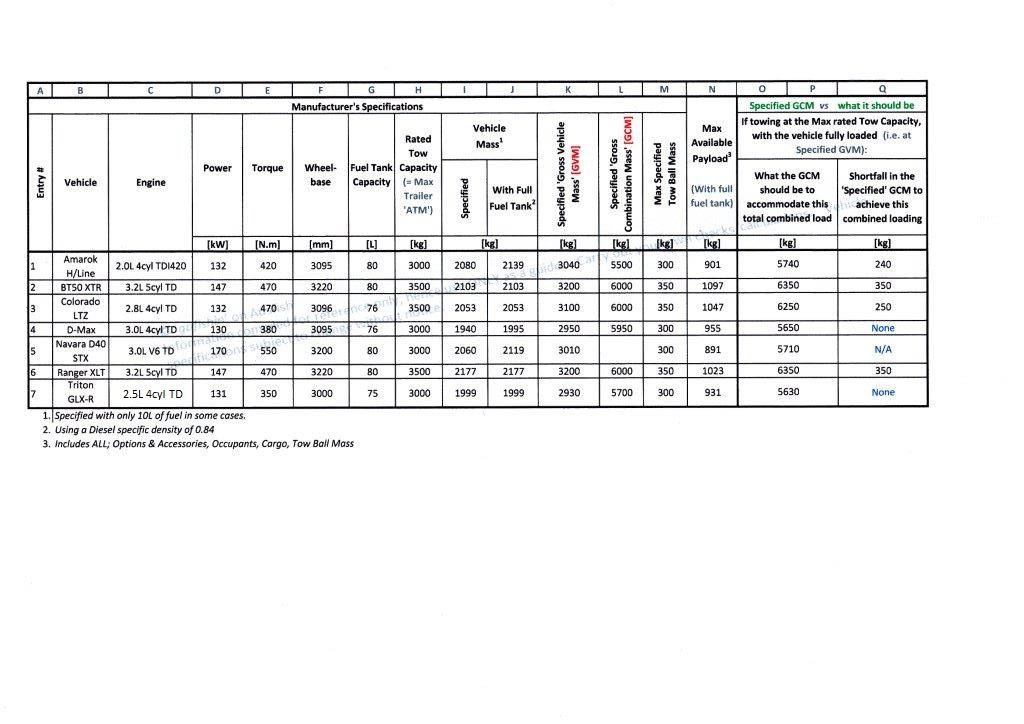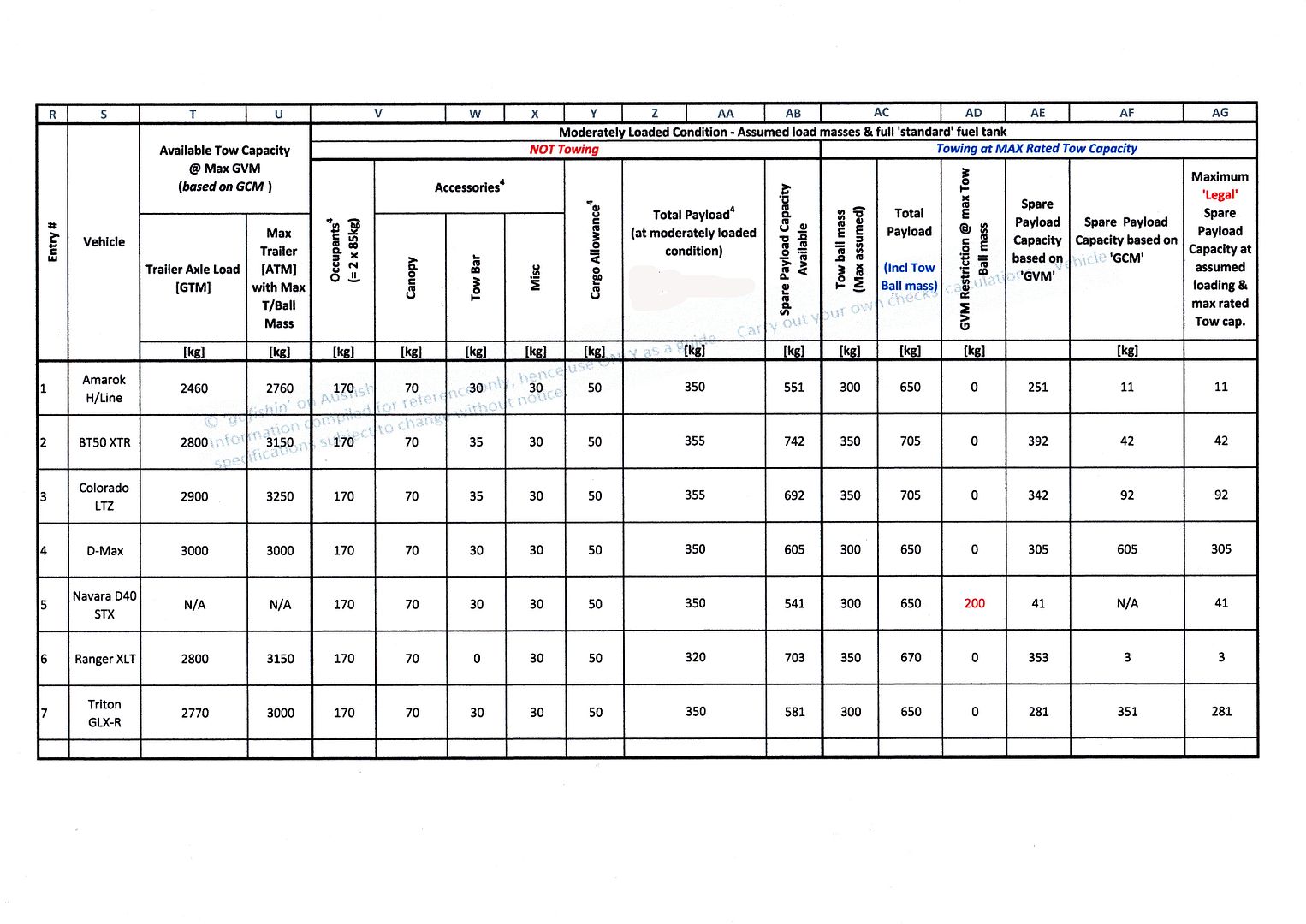About 3 to 4 months ago I started doing some research for a new ‘tow tractor’. At the time ‘I’ thought it was going to be one of the mainstream Dual Cab utes available, so being a numbers man started to compare specs and capacities on these etc while scrutinising brochures.
(Oh, and a Google search didn’t produce any useful comparisons, in particular those that were important to me at the time – towing & ‘staying legal’, diesel, auto, min 3t towing (possibly 3.5t in the future), longish wheelbase.
With a few quick mental calculations it became evident that even though some claimed to be able to tow ‘this much’, doing so with the vehicle loaded meant either the allowable payload or tow capacity needed to be reduced to stay ‘legal’.
At first I was scribbling everything down by hand on a few sheets, but that ended up a big mess so I put it all into Excel with a few calculations and checks etc to make it a bit more clearer and easier to decide what the ‘real specs’ were. This also meant my mates could make use of it too!
In the end I ended up with something which I thought was pretty handy to me….. problem was I forgot about the ‘We’ in ‘I’…..“What, only five seats, that’s not going to work is it dear…” Oops, what was I thinking darling...how much can I spend…!!
Anyway, after a little bit of a clean-up and some formatting etc the info should be pretty handy as a ‘guide/reference’ for others crunching the specs on D/Cabs & towing etc.
Items to note in particular:
· The first Table is mostly 'Specs' obtained from the brochures (and in some cases helpful Ausfishers with a manual or access to relevant info) - except for the last three columns where calculations are performed using the corrected vehicle mass/weight (with full fuel tank), GVM and GCM specs.
· The second Table is basically multiple sets of calculations based on;
Columns T & U - towing with the vehicle loaded to max i.e. at max GVM condition.
Columns V to AB - not towing with the vehicle loaded to a 'moderate condition'.
Columns AC to AG - towing with the vehicle loaded under the same 'moderate condition'.
· Refer to attached for relevant ADR definitions, in particular GVM and GCM are very important for anyone towing anything!
· For those that fit a 'truckload' of accessories and options, be aware that every bit of weight added to the vehicle comes off the available payload and possibly the towing capacity too.
· By Law a ‘GCM’ is not required to be specified for this type/Class of vehicle, however only one model/range presented did not have a GCM specified (Navara).
· The Navara also had a GVM de-rating/restriction based on the condition at max allowable tow ball mass, i.e. when towing 3t. (see the fine detail in their Specs). For a '3t' ute with the most capable engine, this de-rating puts it way behind the D-Max & Triton - and only marginally ahead of the Amarok - in terms of load carrying capacity when towing 3t. I actually sent a Technical Request to Nissan (via a dealer) to confirm this detail, but no reply was received!
· Isuzu provide by far the best ‘payload/capacity’ information and a very detailed ‘as supplied’ vehicle ‘Payload Calculator Sheet’ based on the vehicle purchased with all accessories/options etc, before you drive out the door! I guess this comes from their commercial heritage, where it is extremely important to 'stay legal'!
· Holden/Colly also provide good info & example payload ‘Capacity Calculations’ & checks at the back of their brochure.
· The weights assumed for Options/Accessories etc were taken from the data provided by Isuzu for their D-Max, and then in some cases changed if I thought they might be heavier for other makes. These are assumptions and may not be 'exact' for other manufacturer’s equipment/accessories!
· Only the XLT Ranger included the towbar as standard (and also therefore 'should be' included in the specified vehicle mass – one would hope!)
· Please note that in some cases, when towing the maximum allowable load, that there is sometimes alarmingly little vehicle payload capacity left/available with a few options/accessories, two people and a bit of cargo etc. Refer to the second table.
· Also note that all 3.5t rated Utes come with constraints. You can’t tow 3.5t and load any of these 3 utes up to their full GVM. The Colly is the best (by 50kg) in terms of max available (legal) payload when towing 3.5t. With the Ranger (the worst of the three 3.5t utes for available payload when towing 3.5t), you can only load the vehicle to ~66% (=673/1023) of its allowable payload and still legally tow 3.5t (based on conditions as per the table).
· In the 3t towing capacity there are two makes listed that allow the full 3t towing and allow the vehicles to be loaded to their max GVM capacity (D-Max & Triton).
Disclaimer:
No guarantee is given whatsoever that the information presented is correct, nor that any manufacturers' specifications won’t have changed in the meantime. No liability will be accepted if you make a decision based on the information provided. It is after all, a free public forum, so treat this information as you would any other ‘obtained’ free over the internet – and do the necessary checks/calculations yourself! Blah blah blah...
Cheers
Brendon
PS. tried to attach the tables as jpegs but a lot of detail was lost in reducing them to size etc. Hope Photobucket works OK.
Thanks also to those Ausfishers who have helped me out with info and comments on how their vehicles have performed.








 Reply With Quote
Reply With Quote
 .
.





 .
. 

